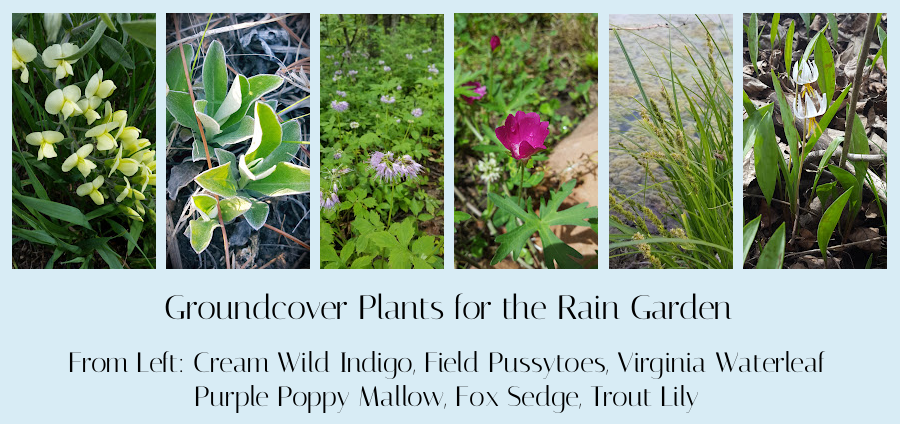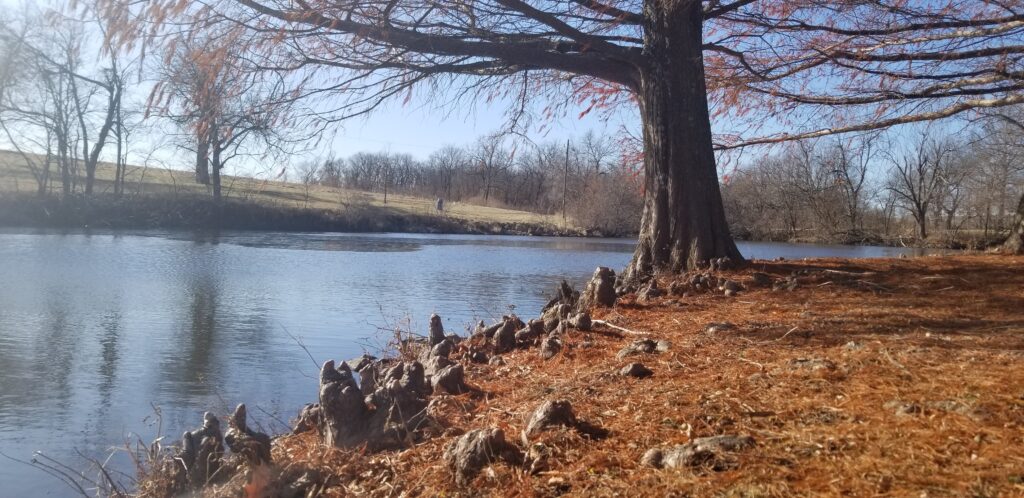What is a rain garden? A rain garden is an area within the landscape that gets the majority of its moisture from rain. It may also get wet from a hose runoff or hillside springs. The rain garden can be a functional and beautiful part of the landscape. I have heard some people call their bog or wetland garden a rain garden, because it would fill up during heavy rain.
The main purpose of a rain garden is to capture runoff before it can enter streams and then bigger bodies of water. Coming off a roof or concrete area, the water can contain heavy metals, pesticides, or other residues which the plants can filter out. Also, the roots of the plants slow the water and hold the soil back, keeping precious soils from building up as sediment in lakes and river deltas.
Rain gardens should be planned and put in an area where the water already runs off quickly. Do not plan to put them in an area where standing water occurs frequently, or where water settles and pools after a rain.
Rain garden plants need to be drought resistant as well as water tolerant. This can be a tough thing for many types of plants. But bog or wetland lovers are often able to cope with the flux between wet and dry. Especially the native plants.
Native Plants for the Rain Garden
Natives plants are the best route to choose when planning your rain garden. Not only are they previously adapted to the regions climate, but they are also able to take the fluctuations between wet and dry better than other plants. Besides, native plants have a relationship with native insects, birds, and other wildlife. By doubling the use of the rain garden plants for pollination and host plants, you get a twice as nice situation.
There are 3 types of rain garden plants you should focus on. These are groundcovers (ground level), structural plants (tall), and dynamic fillers (in-between). Just like designing other types of gardens, you should plan to have all three of these layer to best mimic nature and create a planned plant community. For more help on this idea, check out the book: Planting in A Post Wild World, by Claudia West and Thomas Rainier.
The Groundcover Layer
This is often the most overlooked part of the garden. Usually, we think of a groundcover and a single species of spreading plant used to cover an area where other plants will not grow. But true groundcovers include a mix of plants, some ephemeral, others perennial, and annuals as well. These work and grow together creating a covering beneath the flower and leaf structures of taller plants. And they do not impede the taller plants.
The groundcover layer is similar to the relationship between plants and mycorrhizal fungi in the soil. Both provide benefits to each other, while using each other. It is a mutualistic relationship where both benefit. Plants in this realm are small and often do not have showy flowers. But they are important both to the taller plants and to the wildlife that interacts with them.
Plants for the Groundcover Layer
- Field pussytoes – Antennaria neglecta
- Wild ginger – Asarum canadense
- Sedges – Carex species
- Robin’s plantain – Erigeron pulchellus
- Purple poppy mallow – Callirhoe involucrata
- Prairie petunia – Ruellia humilis
- Virginia waterleaf – Hydrophyllum virginiana
- Virginia bluebells – Mertensia virginica
- Starry campion – Silene stellata
- Cream wild indigo – Baptisia bracteata
- Catclaw Sensitive brier – Schrankia nuttalii
- Dutchman’s breeches – Dicentra cucullaria
- Wild geranium – Geranium macultatum
- Self-heal – Prunella vulgaris
- Trout lily – Erythronium albidum

The Dynamic Filler Layer of the Rain Garden
These are often some of the favorite plants of the gardener. They make up the in-between layer from groundcover to structural. Often, then are quite showy and will bloom for several weeks if not months. Adding them to the rain garden will help promote pollinators and insect interactions between plants. Many of these are also host plants for various butterflies, moths, and other plant feeding insects. An abundance of these will not only drawn in more insects, but more birds and other animals as well.
Plants of the Dynamic Filler Layer
- Sneezeweed – Helenium autumnale
- Purple milkweed – Asclepias purpurascens
- Purple coneflower – Echinacea purpurea
- Bee balm – Monarda species
- Royal catchfly – Silene virginica
- Willowleaf bluestar – Amsonia tabernaemontana
- False sunflower – Heliopsis helianthoides
- Elm-leaf goldenrod – Solidago ulmifolia
- Black-Eyed Susan – Rudbeckia hirta cultivars
- Cardinal flower – Lobelia cardinalis
- Great blue lobelia – Lobelia silphilitica
- Senna – Senna marilandica
- Virginia mountain mint – Pycnanthemum virginianum
- Side-flower Skullcap – Scutellaria laterifolia

The Structural Layer
This layer often towers above the others. Plants in this layer often need extra time for their roots to settle in before they produce a flowering stalk. These are among the longest lived of the perennials in the garden. Structural plants are often also what you see the most of in the winter. These plants have sturdy stems when they do flower.
Plants for the Structural Layer
- Rattlesnake master – Eryngium yuccafolium
- Swamp milkweed – Asclepias incarnata
- Joe Pye Weed – Eutrochium purpureum
- Switchgrass – Panicum virgatum
- Prairie dock – Silphium terabinthinaceum
- Compassplant – Silphium laciniata
- Sweet Coneflower – Rudbeckia ‘Henry Eilers’
- Cutleaf coneflower – Rudbeckia laciniata
- Giant coneflower – Rudbeckia maxima
- Greyhead coneflower – Ratibida pinnata
- New England aster – Symphyotrichum novae-angliae
- False indigo – Baptisia cultivars
- Culver’s root – Veronicastrum virginicum
- Blue vervain – Verbena hastata

Other Plants for the Rain Garden
What about shrubs, trees, or nonnative plants? Do they get to be in the rain garden? Absolutely. Sometimes you just need to try different things to see what works best for you. There are a variety of other plants which do very well in the rain garden and can be incorporated in a variety of ways. Just remember your layers and try to properly position them. And make sure it looks beautiful!
Trees and Shrubs
While trees and shrubs are not typically thought of when designing rain gardens, they can be an integral part of the design. Many of our favorite trees and shrubs, and some others, are great at soaking up water during a flood or rain event. And they are drought tolerant enough to withstand those periods between rain events.
Trees
- Baldcypress – Taxodium distichum
- Black Willow – Salix nigra
- River Birch – Betula nigra
- Sycamore – Platanus occidentalis
- Northern Catalpa – Catalpa speciosa
- American Linden – Tilia americana
- Hackberry – Celtis occidentalis
- Kentucky Coffeetree – Gymnocladus dioicus
- Swamp White Oak – Quercus bicolor
- Pecan – Carya illinoiensis

Shrubs
- Buttonbush – Cephalanthus occidentalis
- Elderberry – Sambucus canadensis
- Swamp Dogwood – Cornus amomum
- Indigo Amorpha – Amorpha fruticosa
- Spicebush – Lindera benzoin
- Black Chokeberry – Aronia melanocarpa
Other Plants for the Rain Garden
- Siberian Iris – Iris siberica
- Daylily – Hemerocallis species
- Reed Grass – Calamagrostis acutiflora ‘Karl Foerster’
- Sea Lavender – Limonium latifolium
Conclusion
Planning and planting a rain garden can benefit not only your landscape, but the infrastructure of your city’s storm water management system. Rain gardens help slow rain and runoff of soil and debris during large rain events, protecting watersheds, lakes, rivers, and oceans. Plantings can be used to encourage pollinators, birds, and other wildlife. And it can be a fun and new way to use your landscape.
Happy planting!




